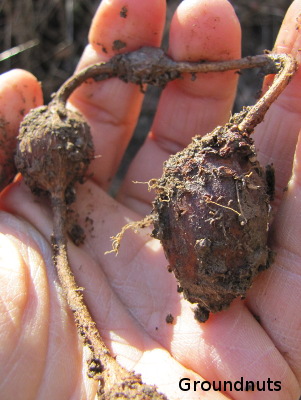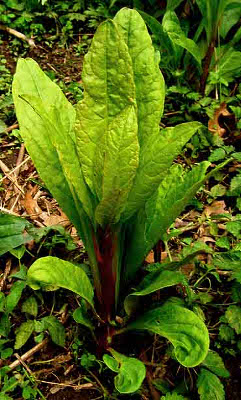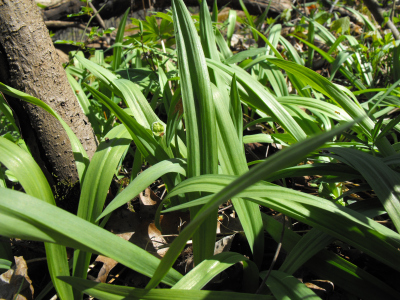
Wildcrafting perennial vegetables
 Since
the plow wasn't introduced to North America until after European
settlement and since perennial vegetables are much easier to manage
with hand tools than annuals are, several of the vegetables profile in
Eric Toensmeier's book were important in the Native American
diet. In some cases, the Native Americans just hunted down the
plants whenever they wanted a meal, but in other cases they would
transplant these perennials into the woods around their settlements for
easier harvest. I sometimes wonder whether the high percentage of
"wild" edibles on our farm is the result of just such an ancient forest
garden.
Since
the plow wasn't introduced to North America until after European
settlement and since perennial vegetables are much easier to manage
with hand tools than annuals are, several of the vegetables profile in
Eric Toensmeier's book were important in the Native American
diet. In some cases, the Native Americans just hunted down the
plants whenever they wanted a meal, but in other cases they would
transplant these perennials into the woods around their settlements for
easier harvest. I sometimes wonder whether the high percentage of
"wild" edibles on our farm is the result of just such an ancient forest
garden.
Our farm is naturally
home to four major perennial vegetables --- arrowheads, poke,
groundnuts, and nettles --- and a fifth (ramps) grow in nearby
woodlands. All five of these natives are good candidates for
simply harvesting sustainably out of the wild, or for introducing to
wild habitats where they might have once grown. I hope to hunt
each one down this year and give them a taste test to determine whether
they're worth cultivating in our forest garden or encouraging in our
wild areas. For those of you unfamiliar with the quintet of wild
edibles, here's a run-down on their uses and cultivation.
Our native arrowheads (Sagittaria
latifolia) were
once important in the diet of Native Americans, while the related
Chinese arrowheads (S.
graminea) are
still planted in rice-paddy-like farms in Asia. In both species,
you eat the small tubers which can be located quite a distance from the
parent plant along its roots, cooking them like potatoes.
Toensmeier recommends planting arrowheads four to five feet apart in
sunny ponds, or in pots in water gardens for easier harvest. The
native species is more cold hardy, but you might get away with growing
the Chinese species if you can keep the roots from freezing (and,
presumably, the Chinese species has been bred to have a better taste.)
 Poke (Phytolacca
americana) is a
common weed in our area, and most old-timers can tell you exactly when
and how to eat it. Although poke has clear potential as an early
spring green, I was always turned off by the careful preparation
required to delete the poisons --- you have to harvest shoots before
they are eight inches tall, carefully cut off any portion that is pink,
then put the edible parts in a pot of water and bring it to a
boil. After the water boils, pour it off and refill the pot with
another round of boiling water, simmering for about five minutes this
time. I can't seem to wrap my head around the idea that there
would be any nutrients and flavor left in the poke after this double
boil, but Toensmeier wrote "I was shocked to discover that the hearty,
rich flavor left me wanting more!", so maybe poke is worth a try after
all.
Poke (Phytolacca
americana) is a
common weed in our area, and most old-timers can tell you exactly when
and how to eat it. Although poke has clear potential as an early
spring green, I was always turned off by the careful preparation
required to delete the poisons --- you have to harvest shoots before
they are eight inches tall, carefully cut off any portion that is pink,
then put the edible parts in a pot of water and bring it to a
boil. After the water boils, pour it off and refill the pot with
another round of boiling water, simmering for about five minutes this
time. I can't seem to wrap my head around the idea that there
would be any nutrients and flavor left in the poke after this double
boil, but Toensmeier wrote "I was shocked to discover that the hearty,
rich flavor left me wanting more!", so maybe poke is worth a try after
all.
Groundnuts (Apios
americana) are
another edible that our farm grows in spades, but which I've refrained
from eating for fear of poisons. I'd read previously that a few
people are allergic to groundnuts and have severe adverse reactions,
but Toensmeier points out that's also true of peanuts and other common
staples. He recommends trying every new perennial vegetable in
small amounts for the first two times before eating your fill
thereafter. Groundnut is an annual vine that naturally grows up
through shrubs and other understory plants in open, damp forests.
You harvest the small, round tubers year-round and cook them like high
protein (16%) potatoes. If we try them out and like the taste, it
would be worth buying one of the varieties that Louisiana State
University has been breeding since those tubers can be up to 5 inches
in diameter rather than the usual one inch. When cultivating
groundnuts rather than just digging them in the wild, plant tubers one
foot apart in the fall and provide a trellis for the vines to twine
around. Groundnuts prefer full sun to partial shade and like
moist soil. After a couple of establishment years, the groundnuts
should be harvested heavily since they tend to take over the garden
otherwise.
Both Stinging Nettles (Urtica
dioica) from
Europe and Wood Nettles (Laportea
canadensis) from
the U.S. are well-spoken of as early spring greens. Once again,
I've known about the benefits of nettles for a long time, but have
steered clear, this time because of the painful stinging hairs.
This spring, I'm going to try to remember to hunt down these early,
nutritious greens, harvest them with gloves, and then boil for two
minutes to deactivate the sting. I don't have any plans to add
them to my garden, though, because Wood Nettles grow quite profusely
right up the hill.

Ramps (Allium
tricoccum and Allium
burdickii) are
the final wild edible that made the cut to be included in Toensmeier's
book. Ramps are so well loved in our area that they are
threatened in the wild from overharvesting, so I've never tasted them,
but I've read that both the bulbs and leaves are edible, with the
former tasting like garlic and the latter like leeks or
scallions. Last year, I transplanted a few ramps into my forest
garden a bit willy-nilly, and this spring I hope to plan ahead a bit
better and get a start that's more likely to take hold.
Toensmeier suggests that ramps can probably be transplanted into many
moist, deciduous forests in the eastern United States and that their
current relative scarcity is due to ant-dispersed seeds which make
ramps slow to recolonize an area after it has been opened up by logging
or agriculture. Ramps are easiest to propagate by dividing
clumps, preferably when they're dormant, but the plants can also be
divided when in leaf if you work with care. You can grow ramps
from seed, too, but it may take two years for the seedlings to
come up from under their preferred thin mulch of leaves. In
either case, space plants 12 to 18 inches apart and harvest lightly
until they are established.
I dug a small batch of
groundnuts up while writing this post, but the other four wild edibles
are going to have to wait until spring for the taste test. My
memory is notoriously faulty, so I hope all of our readers can help
remind me --- if you see that it's ramp, nettle, arrowhead, or poke
season, drop me a comment and send me out in the woods to harvest our
dinner!
| This post is part of our Perennial Vegetables lunchtime series.
Read all of the entries: |
Want more in-depth information? Browse through our books.
Or explore more posts by date or by subject.
About us: Anna Hess and Mark Hamilton spent over a decade living self-sufficiently in the mountains of Virginia before moving north to start over from scratch in the foothills of Ohio. They've experimented with permaculture, no-till gardening, trailersteading, home-based microbusinesses and much more, writing about their adventures in both blogs and books.
Want to be notified when new comments are posted on this page? Click on the RSS button after you add a comment to subscribe to the comment feed, or simply check the box beside "email replies to me" while writing your comment.

Are arrowhead the same as jerusalem artichokes? Aren't the latter native? And isn't the cattail root edible?
Don't forget paw paw, hickory nut, beechnut, walnut, chinkapin, etc.
Fostermamas --- I'm going to have to try poke. People seem to love it --- I just get stuck on the repeated boiling...
Daddy --- Arrowheads are very different from jerusalem artichokes, although both are native. Arrowheads are small wetlands plants with arrowhead-shaped leaves and three-petalled flowers while Jerusalem artichokes are big relatives of the sunflower. You can eat the tubers of both, but after reading up on them both, arrowheads actually seemed to have more potential. I was turned off by the indigestible sugar in Jerusalem artichokes that causes excessive gas...
I certainly didn't mean to say these were all of the native edibles, just that these were the top choices if you take taste into consideration. (Also, left out all of the fruit and nut trees because the book was solely about vegetables.)
I believe it was in the book "1491" that I read that the entire east coast might have been a giant permaculture garden--the colonists reported riding through forests that were routinely burned so that they were as clear of underbrush as a British park. And some thought that they had found paradise because everywhere they looked was something edible, as if by magic.
Not magic, of course. Perennial gardening.
I've been poring over books like that in search of more definitive data, and right now there's a lot of maybes involved. Right now, I'm reading Indian Givers and was intrigued by an anecdote in there about prickly pear cactuses. Apparently, the plants often form solid hedges about 40 feet out from rural houses out west, where they serve as a food patch and also a very thorny fence. The author kept asking people who had planted these hedges, and everyone said they were natural, but they just didn't look natural. Finally, he concluded that people tended to walk about 40 feet out past their houses to use the bathroom, and that the seeds of the prickly pears they ate sprouted in those nice mounds of manure and grew happily. Prickly pears that sprouted up too close in were eradicated, so the hedges were some combination of natural and man-made.
I suspect a lot of that happened in the eastern U.S. too with things like persimmons, pawpaws, etc., and it's really tough for us distinguish between natural and man-made plant ranges. I'll just keep combing the literature for more definitive answers! I feel like it must be out there!
My first comment!
I love poke. It was the first wild food my grandfather taught me. As long as you don't try to eat anything bigger around than your thumb, its delicoius. Any bigger an dits too tough. We usually just fry it in flour, salt and pepper. Yummy.
I've been told since that the toxins damage your chromosomes but my grandparents ate it every spring and are fine. I think it's one of those "causes cancer in lab rats" situations, where you have to eat more than any one person ever would (especially considering that it's really only in season for a couple weeks, tops.)